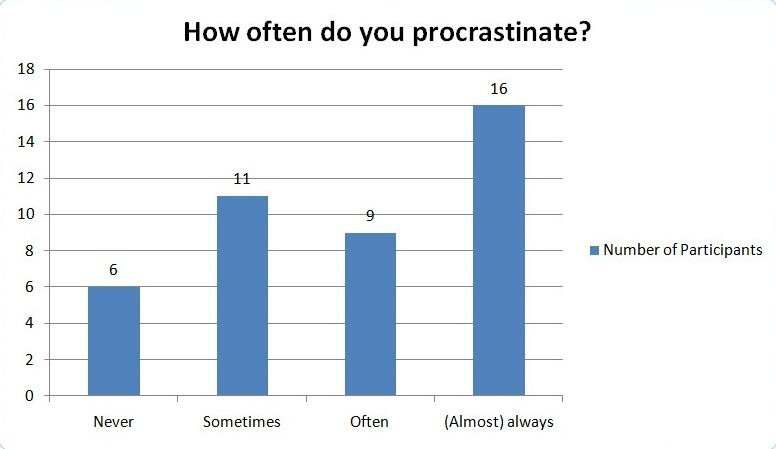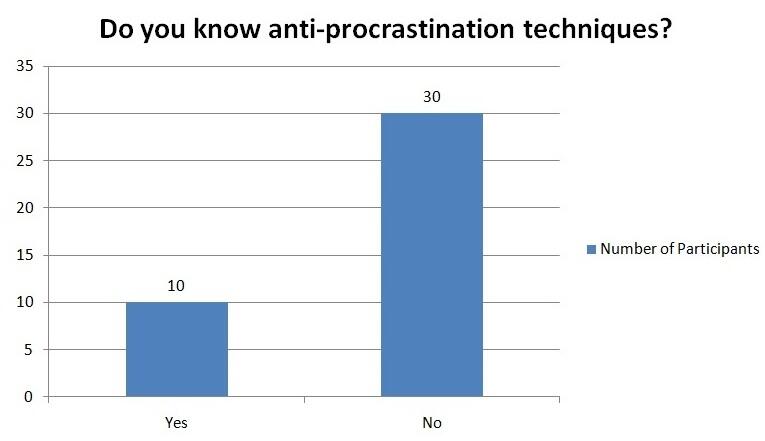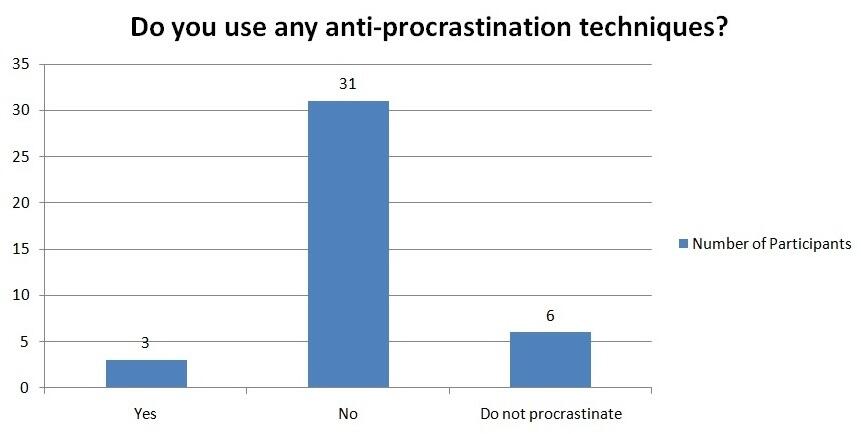Abstract
Procrastination is an important problem among university students, for it wastes their time, decreases their effectiveness, lowers their academic achievements, leads to stress, and might even cause mental and/or psychological problems. The current study used a survey to find out how often students of a university procrastinate, whether they know any anti-procrastination techniques, and if they use them. It was found that the majority of respondents (85%) experienced problems with procrastination, and, while some of them (25%) knew some anti-procrastination techniques, very few (7.5%) utilized them in practice. The findings imply that it might be useful to help university students address their procrastination issues.
Introduction
The problem of procrastination, or a voluntary (Ferdus, Kabir, & Akter, 2016) but irrational delay of doing a certain task (Sabri, Hamdy, El-Wasify, El-Wasify, & Saleh, 2016), is considerable in many populations, including university students (Meier, Reinecke, & Meltzer, 2016). It has numerous negative impacts upon learners, including lowered productivity and academic performance, anxiety over the delay and stress, emotional and health problems, etc. (Ferrari & Díaz-Morales, 2014; Sabri et al., 2016). Also, much time is wasted; according to Meier et al. (2016), the mean delay when procrastinating using Facebook exceeds 70 minutes. It is stated that from 46% to 95% of learners procrastinate while working on academic tasks, and nearly one-third of them experience severe problems with procrastination (Ferdus et al., 2016).
Certain motivation strategies may help students address procrastination issues (Grunschel, Schwinger, Steinmayr, & Fries, 2016). Also, a variety of techniques exist for battling procrastination (Khezri & Mohamadi, 2015). However, little research on the use of anti-procrastination techniques among students has been found. Therefore, the current study is aimed at investigating the following question: “Do university students know any anti-procrastination techniques, and do they use them in practice?”
Methods
Participants
The participants of this study were students of the University of Iowa recruited at the campus. The convenience sampling technique was utilized. The recruitment process lasted until 40 respondents were surveyed.
Procedures
The students were approached and asked to complete the survey (see Appendix). The informed consent of all the participants was gathered. Two persons refused to complete the survey and were not included in the sample. After the responses were collected, the results were transferred to the computer.
Data Analysis
The data was analyzed using Microsoft Excel software. Bar charts were created demonstrating the percentages of learners concerning their answers.
Results
The results of the survey are presented in Figures 1-3 below.

As Figure 1 above demonstrates, 6 respondents (15%) claimed that they never procrastinate, 11 participants (27.5%) stated that they procrastinate sometimes, 9 students (22.5%) said that they often engage in procrastination, and 16 learners (40%) admitted procrastinating always or almost always while doing academic tasks. Thus, 34 participants (85%) were found to procrastinate at least sometimes. This is consistent with Ferdus et al. (2016) and confirms the prevalence of the problem of procrastination.


Figure 2 above displays that 10 respondents (25%) stated that they knew at least some anti-procrastination techniques. However, as Figure 3 above demonstrates, only 3 participants (7.5%) claimed that they utilized anti-procrastination techniques in practice, whereas 31 students (77.5%) admitted that they did not use any such techniques. The rest, 6 learners (15%), asserted that they did not procrastinate (which implies that they did not need such techniques), as was also shown in Figure 2. Therefore, it can be seen that very few students responded that they knew anti-procrastination techniques, and even fewer learners stated that they employed these methods in practice.
Discussion
Therefore, the current study revealed that a prevalent proportion of university students (85%) procrastinate while studying, and a considerable amount of these learners (40%) admitted that they had severe procrastination problems, wasting time almost whenever they needed to study. Also, not a large percentage of respondents stated that they knew some techniques for battling procrastination (25%), and only 7.5% of participants responded that they used these techniques in practice.
However, the current study had several limitations. First and foremost, a non-probability, convenience sampling technique was used, and all the participants were recruited from only one university, which considerably limits the possibility to generalize the results. Also, the first question of the survey (see Appendix) did not specify the meaning of the frequency terms (sometimes / often / almost always), leaving them for the participants to interpret as they desired.
On the whole, this study implies that it might be useful to provide university students with training aimed at helping them address their procrastination issues. Other methods, such as certain ways to increase their motivation (Grunschel et al., 2016), may also be employed.
Future research could be conducted to confirm (or deny) the results of the current study using a probability sampling technique, a larger sample and population, and more valid surveys. Besides, the effects of different methods and techniques could be compared to find out which ones are more effective and are best for university students.
References
Ferdus, Z., Kabir, T., & Akter, S. (2016). Time management behavior among academic procrastinators in Bangladesh: A study on undergraduate students of different private universities. Journal of Business and Technology (Dhaka), 10(2), 37-56.
Ferrari, J. R., & Díaz-Morales, J. F. (2014). Procrastination and mental health coping: A brief report related to students. Individual Differences Research, 12(1), 8-11.
Grunschel, C., Schwinger, M., Steinmayr, R., & Fries, S. (2016). Effects of using motivational regulation strategies on students’ academic procrastination, academic performance, and well-being. Learning and Individual Differences, 49, 162-170.
Khezri, M., & Mohamadi, M. (2015). The effect of hope therapy on reduction of academic procrastination: The case study of PTSD students. International Journal of Academic Research, 7(3a), 222-226.
Meier, A., Reinecke, L., & Meltzer, C. E. (2016). “Facebocrastination”? Predictors of using Facebook for procrastination and its effects on students’ well-being. Computers in Human Behavior, 64, 65-76.
Sabri, Y., Hamdy, I., El-Wasify, M., El-Wasify, M., & Saleh, E.-S. (2016). Causal attributions and executive functions of academic procrastination in Mansoura University students. Egyptian Journal of Psychiatry, 37(2), 70-78.